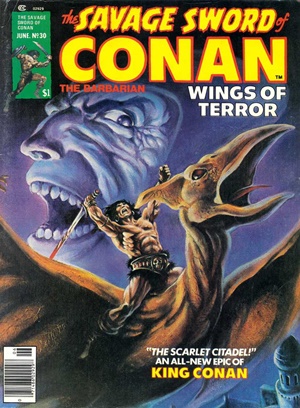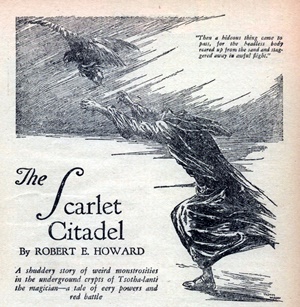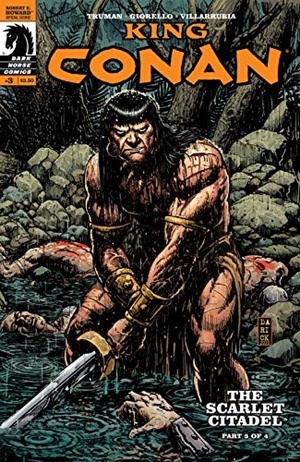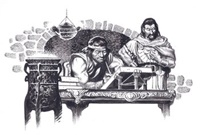Hither Came Conan: John C. Hocking on “The Scarlet Citadel”
 I’m here to sing the praises of Robert E. Howard’s Conan story, “The Scarlet Citadel.” This classic yarn first appeared in the January 1933 issue of Weird Tales and was the second Conan story to see print, following “The Phoenix on the Sword.” This is a tale of Conan when he was King of Aquilonia, and many, Karl Edward Wagner among them, have noted it shows clear parallels to Howard’s only Conan novel, the peerless The Hour of the Dragon.
I’m here to sing the praises of Robert E. Howard’s Conan story, “The Scarlet Citadel.” This classic yarn first appeared in the January 1933 issue of Weird Tales and was the second Conan story to see print, following “The Phoenix on the Sword.” This is a tale of Conan when he was King of Aquilonia, and many, Karl Edward Wagner among them, have noted it shows clear parallels to Howard’s only Conan novel, the peerless The Hour of the Dragon.
In “The Scarlet Citadel,” Amalrus, King of Ophir, requests military aid from Aquilonia, saying that the kingdom of Koth, ruled by Strabonus, is pushing over his borders. Conan comes to the aid of an ally in need, of course, but soon finds he has been deceived, that Amalrus and Strabonus are in league to betray and entrap the Cimmerian and his army. Conan’s forces are mercilessly destroyed, and he is captured and tossed into the dungeons of a sorcerer of Koth, Tsotha-lanti. This wizard has been using his dungeons to work eldritch experiments and otherwise practice occult deviltry, the result being a dark underworld setting as memorable as Tolkien’s Moria.
Attempting to escape the dungeon, Conan encounters Pelias, a wizardly foe of Tsotha-lanti, and sets him free from the embrace of a grotesque plant. Pelias, sinister but apparently genuinely grateful, helps Conan escape and get back to Aquilonia, where the barbarian eventually leads an army against his enemies in a spectacularly described battle.
Forming the tale’s climax, this battle juxtaposes close combat with sweeping scenes of massed armies in thunderous conflict. Perhaps this is sacrilege, but these battle sequences, as uniformly wonderful as they are, simply don’t move me as much as the scenes of the Cimmerian’s more personal encounters.
 Even noting this contrast seems somewhat unfair when I consider that many of Conan’s scenes in “The Scarlet Citadel” are among the most memorable that Howard ever put on the page. The Cimmerian comes to startlingly vivid life as REH has him demonstrate defiance, courage, loyalty, rage, nobility and humility in both deeds and in sharp, pithy dialogue.
Even noting this contrast seems somewhat unfair when I consider that many of Conan’s scenes in “The Scarlet Citadel” are among the most memorable that Howard ever put on the page. The Cimmerian comes to startlingly vivid life as REH has him demonstrate defiance, courage, loyalty, rage, nobility and humility in both deeds and in sharp, pithy dialogue.
One small moment that has always stood out for me is when the sorcerer Pelias, released from his bondage and making free with the luxuries of Strabonus’s palace, recognizes Conan as a King and offers to serve him some wine. The Cimmerian simply won’t let him do it, pouring a goblet for Pelias then drinking from the bottle himself. Our hero clearly believes in a rough comradery among companions in adversity, even if his companion happens to be a fearsome sorcerer.
Some of the finest and most memorable scenes of dark sorcery in the canon can be found here, fantastical imaginings that fit the Cimmerian’s saga as neatly as a stiletto does its sheath. This is a classic Weird Tale that veers deeply into supernatural horror and does so with such skill and vision that several scenes surely number not only among the finest examples of the dark fantastic put forth by REH, but as highlights of fantasy fiction as a whole.
Conan’s groping through the nighted dungeons beneath “The Scarlet Citadel” are superb in both conception and execution, amounting to a tour de force of macabre fantasy. It is tempting to simply list a catalog of the wonderfully chilling encounters Conan has in this sequence, but one in particular clearly displays not only REH’s well-renowned lush imagination, but also his less celebrated mastery in structuring a story.
 The Cimmerian is chained in the dungeons beneath the Scarlet Citadel, a maze populated by weird and menacing creatures dominated by a slinking albino snake 80 feet long. REH shows the serpent to the reader twice to build trepidation and suspense.
The Cimmerian is chained in the dungeons beneath the Scarlet Citadel, a maze populated by weird and menacing creatures dominated by a slinking albino snake 80 feet long. REH shows the serpent to the reader twice to build trepidation and suspense.
The first time is when it kills a foe of Conan who foolishly comes into the dungeons to taunt the shackled King. It strikes like a rattler, with force enough to knock the man across the corridor, then swiftly wraps the luckless wretch in its coils like a constrictor. Bones crunch. This scene drives home how fearfully lethal this creature is.
Later Conan encounters the snake while stealing through the corridors seeking escape, and he freezes in place while it glides past. Brilliantly, REH has a nigh invisible demon, lurking in the darkness undetected beside Conan, reveal itself only when the presence of the serpent causes it to flee. The horrors of the pit themselves fear the pale snake, chief horror in a kingdom of horrors.
Having neatly established the serpent as an overwhelmingly formidable force of evil, what does REH do? Does he have Conan come to grips with the thing and battle it? You couldn’t blame any reader of heroic fantasy to expect that, perhaps even to see it as inevitable, but REH ultimately uses it to much more resonant and memorable effect.
When, in his dungeon wandering, Conan discovers the imprisoned wizard Pelias, he releases him from the grip of a demonic plant grotesque enough that I can imagine it drawing a grin from Clark Ashton Smith. Pelias displays a helpful attitude to the barbarian who freed him, but there is clearly more to him than is readily seen and he doesn’t seem like a good man to cross. This becomes vividly clear when he and Conan abruptly come face to face with the pallid serpent. Conan braces himself for desperate combat but, in a remarkable climax to the author’s handling of his ophidian villain, the serpent gazes at Pelias, then turns and flees.
When Conan wonders why, Pelias replies, “The scaled people see what escapes the mortal eye… You see my fleshly guise; he saw my naked soul.”
The serpent’s narrative thread is built skillfully toward this brief scene, to which it forms a kind of climax while also illuminating the character of Pelias with unique power. If the reader had any doubt about the sinister, veiled power of Pelias, it is dispelled by the revelation that the fearsome albino serpent turns in full retreat after simply getting a good look at him.
This small, carefully wrought sequence has impact enough that it could serve as the climactic conclusion of a short horror story, but it’s just another remarkable element woven into “The Scarlet Citadel,” inarguably a superb work of heroic fantasy and a lustrous gem among the treasure trove that is Robert E. Howard’s saga of Conan the Cimmerian.
From the Dusty Scrolls (Editor comments)
The second story written after Howard completed “The Hyborian Age,” it reflects his world building, with the multiple nations and political intrigues.
Conan’s trek underneath the Scarlet Citadel is a classic dungeon crawl, decades before the term came into use.
Howard, again, pushes forward his view on ‘barbarism vs. civilization.’ The scene in which Conan faces his captors and gives his speech about who is more suitable to be a king, is one of this best pieces of writing in the Conan Canon.
Howard continues ending his Conan stories with an element of the fantastic – certainly appealing to Weird Tales readers, as well as editor Farnsworth Wright.
Touched on by John, Howard drew heavily on this story for his lone Conan novel, The Hour of the Dragon. When Raymond Chandler cobbled together his short stories into novel form, I think he called it ‘repurposing.’
Prior Posts in the Series:
Here Comes Conan!
The Best Conan Story Written by REH Was…?
Bobby Derie on “The Phoenix in the Sword”
Fletcher Vredenburgh on “The Frost Giant’s Daughter”
Ruminations on “The Phoenix on the Sword”
Jason M Waltz on “The Tower of the Elephant”
Up Next Week: Morgan Holmes looks at “Iron Shadows in the Moon/Shadows in the Moonlight”
John C. Hocking is the author of the forthcoming Conan and the Living Plague. His short fiction has appeared in Flashing Swords, Black Gate, Skelos, and Tales From the Magician’s Skull. His novella Black Starlight is currently being serialized in Marvel’s new Conan the Barbarian comic.
 Bob Byrne’s ‘A (Black) Gat in the Hand’ was a regular Monday morning hardboiled pulp column from May through December, 2018.
Bob Byrne’s ‘A (Black) Gat in the Hand’ was a regular Monday morning hardboiled pulp column from May through December, 2018.
His ‘The Public Life of Sherlock Holmes’ column ran every Monday morning at Black Gate from March, 2014 through March, 2017 (still making an occasional return appearance!).
He also organized Black Gate’s award-nominated ‘Discovering Robert E. Howard’ series.
He is a member of the Praed Street Irregulars, founded www.SolarPons.com (the only website dedicated to the ‘Sherlock Holmes of Praed Street’) and blogs about Holmes and other mystery matters at Almost Holmes.
He has contributed stories to The MX Book of New Sherlock Holmes Stories – Parts III, IV, V and VI.
And he will be in the anthology of new Solar Pons stories coming this year.

I’m a very big fan of the battle scenes in this one – they strike me as some of the most excellent zoomed-out, big picture combat moments I’ve read in any genre.
The early Conan stories certainly feature an embarrassment of riches! What a way to start a series! It’s like Howard had all these ideas in him he couldn’t wait to get out, and poured them all into the first few stories. Those slated to extol the later tales, that measure out the wonders more parsimoniously, will have their work cut out for them. I anticipate the use of such words as “technique,” “control” and “mastery” in place of “imagination.” But hey, I’m sure they’ll make it work.
But if Hocking has an easy time of it here, he doesn’t coast. He knows his Howard and knows his Conan, as evidenced by the way he nailed it, once upon a time, with CONAN AND THE EMERALD LOTUS. (If the long-buried LIVING PLAGUE is indeed to see light of day it will have many eager readers.) Here he shows us Howard firing on all cylinders, and lets us see how the man did it. Good show!
That said, I very much look forward to see how Morgan Holmes touts the primacy of the next story, the first of the “middle Conans” following the strong start of “Phoenix,” “Frost,” “Tower” and “Scarlet.”
Brian – ‘The Living Plague’ absolutely is going to be published. I think this year.
And I might be a little off on the specifics, but he also has a 16,000-ish word prose novella that is being published in current issues of the new Conan comic book. I don’t have a copy yet, but that’s my understanding.
I think it takes place after the end of ‘Emerald Lotus.’
So, much cool Hocking stuff coming for us!!!!
Blee – EXACTLY my thought in re-reading this for the post. I am so impressed with Howard’s descriptions of the mass battle scenes. I think he’s fantastic at it.
“Howard’s tales of elder worlds are growing rapidly in stature, and now and then—as in “The Scarlet Citadel” and “The Tower of the Elephant”—reach a level of really tremendous power.”
– H. P. Lovecraft to Farnsworth Wright, 18 Jun 1933, Lovercraft Annual #8, p32
Excellent article John. I’m not usually a fan of large scale battle scenes myself since they are so difficult to do well, but I felt Howard did an excellent job with the battle in Scarlet Citadel. However, I do agree that Howard excelled in the personal combat; it’s extremely visceral.
Scarlet Citadel is also a good example of how Conan can be tricked using his barbaric background. Conan treats his allies with honour and he expect the same in return. A more ‘civilised’ king would have perhaps been more wary of his allies and their ultimate intentions.
This series continues to be a treat. Looking forward to the next instalment.
Nice and fun recap, John. This story is one of my true favorites for all the points you’ve established and comments have included.
I find it interesting to consider that this story works so well, so perfectly, because of the timing of its writing. If REH had written this after several more of Conan’s adventures, I’m not sure he would have allowed the barbarian to be tricked so easily. As Conan ages and experiences ‘civilized’ men, he does grow more wary. I think this would have been a different tale if Howard had had more of Conan’s background experiences already written. I’m glad it was written when it was.
Where did this one first appear in book form?
My favorite Conan tale. And the best part of it? The relationship between Conan and Pelias, which Hocking acknowledges as a major strength of this unforgettable tale. My minor nitpick is that Pelias, while no doubt powerful and intimidating, should be described as sinister.
Hey R.K.
I believe The Scarlet Citadel first appeared between the covers of a book in King Conan from Gnome Press back in 1953.
> The peerless The Hour of the Dragon…
Yeah, much as I like “The Scarlet Citadel,” I like it better when redone as The Hour of the Dragon. I think REH also solved the issue with the battle scenes in The Hour of the Dragon by keeping them mostly off page and letting the personal conflicts become the focus.
But I’m getting ahead of myself considering which story I was randomly assigned.
R.K. and John — The Scarlet Citadel actually first appeared in book form in Skull Face and Others from Arkham House in 1946. But King Conan was where it appeared next.
If there’s a better place to find online info on when a Howard story was printed, I sure as heck don’t know what it is!
Howard Works
I always loved that business with the snake and Pelias. And I completely concur with Robert E. Howard’s mastery with huge battle scenes. He is one of the few writers who can really knock those out of the park.
First, let me add by linking some more images. Ones done by the last one. He has a really good feel for “Eldritch Horror” like Clark Ashton Smith stuff.
Got the depraved sorcerer Tsotha Lanti
https://www.deviantart.com/mrzarono/art/Sorcerer-of-the-Scarlet-Citadel-412746159
And the tree … “What is rooted in Hell must be watered with Blood!”
https://www.deviantart.com/mrzarono/art/What-is-rooted-in-hell-must-be-watered-with-blood-686088088
I liked their depiction of the Depraved Sorcerer – the best – IMO it influenced a character in the first “Lobster Johnson” stand alone in the Hellboy universe. I’m going to make some subtle references to him in my pulps – using of course now public domain references. Nothing major, just tip o the hat and such.
Dark Horse comics did a brilliant adaptation of this work. Have it both on my tablet and a physical edition. Worth it just for the art if as a strong hobby you practice drawing hoping to illustrate your own stories on a near professional level some day.
But Dark Horse’s 00s till around now revival of the Conan license was incredible the first few years. Kept a high art standard and was very close to the pulps and REH story in adaptations. I had problems with later ones but some they did perfect and this is even after decades of Marvel doing it multiple times – at least twice each story for comic book and magazine formats.
My favorite part – besides being better to the story most times – is that when narration is necessary they went to direct quotes from REH stories – made to look like typewriter characters on pulpy yellow paper. Well I’m sure REH had white new paper and the end result was more printing fonts Weird Tales used printed on the cheap, quickly yellowing pulps so it’s a compromise but fits both appeals.
As far as – citing the comments – the issue with King Conan falling for such a trap? Uh, in RL, which REH read as much of as possible there are plenty of conquerors who had problems once the bloody crown was on their heads. REH based Conan (and Kull) off many such historical examples right back to Odo Iser and others.
Conan was made a hero – hence “Heroic Fantasy” by being able to overcome such a thing and refusing an easy out.
“He cursed himself for his refusal of their offer, even while his stubborn manhood revolted at the thought, and he knew that were he taken forth and given another chance, his reply would be the same. He would not sell his subjects to the butcher. And yet it had been with no thought of anyone’s gain but his own that he had seized the kingdom originally. Thus subtly does the instinct of sovereign responsibility enter even a red-handed plunderer sometimes.” – citing the original source on wikisource
Green – I have Dark Horse’s Citadel in ebook. I’m hoping Marvel will reissue the whole King Conan line.
What makes “The Scarlet Citadel” the best Conan story ever? Not only is it a well plotted story, but it has Howard paying homage to Lovecraft and Smith, thus creating a even greater world than his Hyborean Age, by also combining it with The Cthulu Mythos. And so, starting in 1932, we’re seeing Weird Tales become a more cohesive magazine with a distinct editorial direction and with authors riffing on one another.
For “The Scarlet Citadel”, Howard takes a simple story plot, a double-cross, kidnap, escape and revenge, and creates a story that attacks our preternatural and instinctual phobias and then with great wordplay instills in us a visceral fear that we can’t combat with any physical effort. Conan is not a young upstart who fights fright with physical action, but a more mature man who thinks and analyzes and flees. The concept is sort of a bridge to what is actually occurring in Howard’s real life. Where he is growing and starting to handle and deal with more mature life issues. Subsequent Conan stories deal with work-for-hire and girlfriends. Both life issues that Howard was going through.
It’s no wonder that Howard, in a couple of years, utilizes this story as a blueprint for an expanded Conan novel. The plot having a more mature and developed Conan than a young and quick-tempered one. Howard has the idea that a novel with this concept would appeal to a much larger and discerning audience.
If Howard had lived into his 40’s and 50’s, I believe he would have gone back to the Conan character and written a story examining King Conan again with even more mature subjects like marriage, children, old age and death.
“Conan discovers the imprisoned wizard Pelias, he releases him from the grip of a demonic plant grotesque enough that I can imagine it drawing a grin from Clark Ashton Smith”
Yes! I believe that CAS and REH had already begun to influence one another at this point. I wonder what their work would have looked like WITHOUT this kind of cross-pollination?
I am starting to become frustrated by this series. In a good way. The articles are all of such a high standard, along with the commentary and good natured banter. How on earth am I going to decide which Conan story was the best?
Tony – Ha!
That means the writers are doing a good job.
While I pitched it as a ‘Best of Conan’ series (I didn’t even come up with the Hither title until shortly before it began running), the real idea was for folks to highlight what was good about Howard in each story.
So even if the story is a relative ‘dog,’ we can still see the skill and ability of Howard in telling it.
I got lucky in getting ‘Rogues in the House,’ which I think is a fantastic story.
Some folks have to work a lot harder!!!!
And all of the assignments were truly random. I didn’t even slant it to favor myself.
Excellent post, John. I’m a little late to the conversation. I’ve had to battle the demons of Dayjobbery and Reallife this week, but I have (mostly) prevailed.
I think I got a greater appreciation of the story on this reread than I had before. One thing no one has mentioned is the backstory of the citadel. In Chapter III Pelias tells Conan a bit about Khossus V finding the pits when he built his palace three thousand years earlier on the site of a previous city and the history of what followed. Howard only took three paragraphs before bringing Satha the snake back on stage, but those paragraphs were as effective in what they told as they were in what they left out. Howard left me wanting to know more about what had happened in the citadel.
I also found the poetry at the head of each chapter to be quite effective in shaping the mood of what was to follow.
And one final comment,then I’ll shut up. John you mentioned the supernatural horror components in the story. I thought Pelias reanimating the corpse of Shukeli to open the grille and let them out was one of the most effective uses of supernatural horror in the story. Instead of relying on suggestion and the reader’s imagination, Howard showed you everything in gory detail, no pun intended.
Life has me playing catch up with this series. I’m hoping to be back up to speed by Sunday night.
This one was much better than I remember it. The only thing i remembered when i sat down was the end.
I love the large scale battles here. Howard really provides you with just the right words to get a birds eye view of the action. Especially the opening chapter.
You can picture the groups of soldiers running out of things to fight. So they all start moving to the one spot where people are still fighting.
This one is my favorite so far.
[…] Recently, Black Gate, an online magazine about fantasy fiction, released a series of article about Robert E. Howard’s original Conan stories. Each article was written by a prominent REH scholar. The authors were randomly assigned a story and given the task of persuading readers that their assigned story was the best Conan story. Here’s a great article from that series. […]